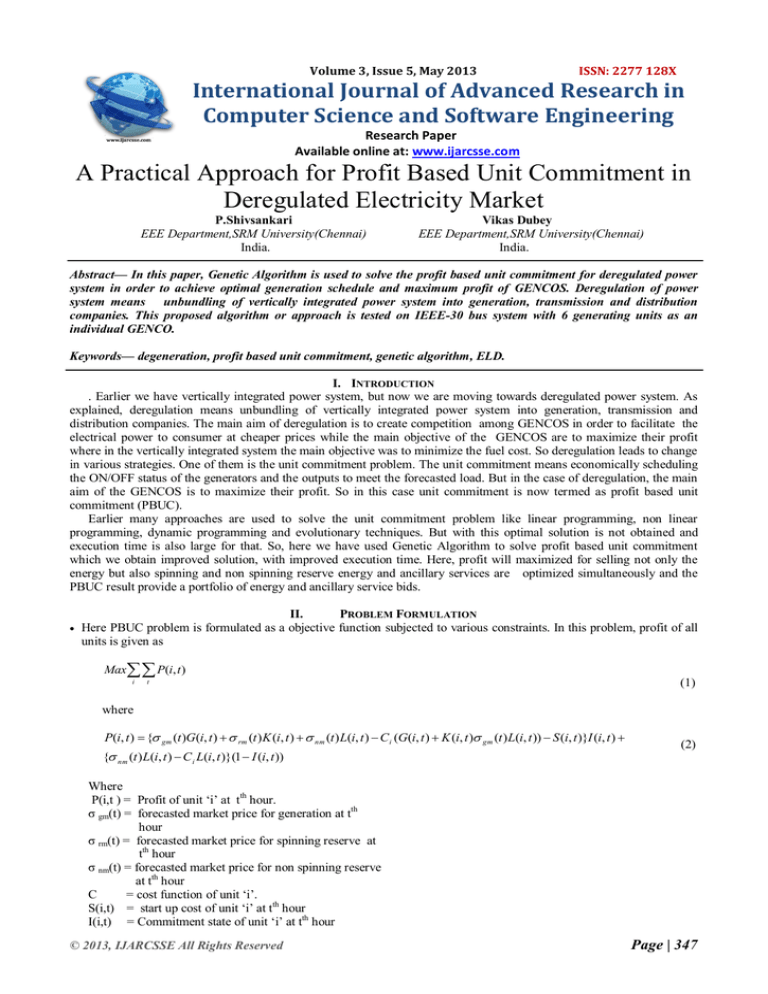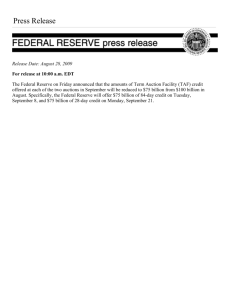
Volume 3, Issue 5, May 2013
ISSN: 2277 128X
International Journal of Advanced Research in
Computer Science and Software Engineering
Research Paper
Available online at: www.ijarcsse.com
A Practical Approach for Profit Based Unit Commitment in
Deregulated Electricity Market
P.Shivsankari
EEE Department,SRM University(Chennai)
India.
Vikas Dubey
EEE Department,SRM University(Chennai)
India.
Abstract— In this paper, Genetic Algorithm is used to solve the profit based unit commitment for deregulated power
system in order to achieve optimal generation schedule and maximum profit of GENCOS. Deregulation of power
system means unbundling of vertically integrated power system into generation, transmission and distribution
companies. This proposed algorithm or approach is tested on IEEE-30 bus system with 6 generating units as an
individual GENCO.
Keywords— degeneration, profit based unit commitment, genetic algorithm, ELD.
I. INTRODUCTION
. Earlier we have vertically integrated power system, but now we are moving towards deregulated power system. As
explained, deregulation means unbundling of vertically integrated power system into generation, transmission and
distribution companies. The main aim of deregulation is to create competition among GENCOS in order to facilitate the
electrical power to consumer at cheaper prices while the main objective of the GENCOS are to maximize their profit
where in the vertically integrated system the main objective was to minimize the fuel cost. So deregulation leads to change
in various strategies. One of them is the unit commitment problem. The unit commitment means economically scheduling
the ON/OFF status of the generators and the outputs to meet the forecasted load. But in the case of deregulation, the main
aim of the GENCOS is to maximize their profit. So in this case unit commitment is now termed as profit based unit
commitment (PBUC).
Earlier many approaches are used to solve the unit commitment problem like linear programming, non linear
programming, dynamic programming and evolutionary techniques. But with this optimal solution is not obtained and
execution time is also large for that. So, here we have used Genetic Algorithm to solve profit based unit commitment
which we obtain improved solution, with improved execution time. Here, profit will maximized for selling not only the
energy but also spinning and non spinning reserve energy and ancillary services are optimized simultaneously and the
PBUC result provide a portfolio of energy and ancillary service bids.
II.
PROBLEM FORMULATION
Here PBUC problem is formulated as a objective function subjected to various constraints. In this problem, profit of all
units is given as
Max P(i, t )
i
t
(1)
where
P(i, t ) { gm (t )G(i, t ) rm (t ) K (i, t ) nm (t ) L(i, t ) C i (G(i, t ) K (i, t ) gm (t ) L(i, t )) S (i, t )}I (i, t )
{ nm (t ) L(i, t ) C i L(i, t )}(1 I (i, t ))
(2)
Where
P(i,t ) = Profit of unit „i‟ at tth hour.
σ gm(t) = forecasted market price for generation at tth
hour
σ rm(t) = forecasted market price for spinning reserve at
tth hour
σ nm(t) = forecasted market price for non spinning reserve
at tth hour
C
= cost function of unit „i‟.
S(i,t) = start up cost of unit „i‟ at tth hour
I(i,t) = Commitment state of unit „i‟ at tth hour
© 2013, IJARCSSE All Rights Reserved
Page | 347
Shivsankari et al., International Journal of Advanced Research in Computer Science and Software Engineering 3(5),
May - 2013, pp. 347-352
ISi
= initial state of units
G
= Generation,
R
= Spinning Reserve
M
= Non spinning reserve.
The profit based unit commitment is subjected to various
constraints
G (i, t ) I (i, t )G
max
(3)
(t )
i
K (i, t ) I (i, t )K
max
(t )
(4)
(t )
(5)
i
L(i, t ) I (i, t )N
max
i
These constraints give flexibility to GENCOS in order to control maximum level of generation, spinning reserve and
non spinning reserve that GENCOS are willing to produce. Some other constraints.
G(i, t ) I (i, t )0
(6)
Gg min (i)G(i, t ) I (i, t ) K (i, t ) I (i, t ) L(i, t )I (i, t )Gg max
(7)
K (i, t ) I (i, t )K s (i, t ) I (i, t )
(8)
where
K s (i, t ) min{10* MSR(i), Gg max (i) h(i, t )}
h(i, t )l0 (i, t )
l0 (i, t ) q(i)
(9)
(10)
, if unit „i‟ is off
(11)
l0 (i, t ) l s (i, t ) , if unit „i‟ is on
(12)
K s (i, t ) min{10* MSR(i), Pg max (i) P(i, t ) R(i, t )}
(13)
where Ks(i,t) contribution of unit „i‟ to spinning reserve at tth hour
MSR is the maximum sustained ramp rate (MW/min) the spinning reserve is unloaded synchronised generation that
can ramp up in 10 minutes.
Unit minimum ON/ OFF duration
X
X
(i, t ) T on (i) * I (i, t 1) I (i, t )0
off
(i, t ) T off (i) * I (i, t 1) I (i, t )0
on
Where
Xon = time duration for which unt I has been ON at time„t‟
Xoff = time duration for which unt I has been OFF at time„t‟
Ton = minimum ON time of unit „i‟
Toff = minimum OFF time of unit „i‟
III.
GENETIC ALGORITHM
It is an optimization technique based on natural evolution process. In GA, each variable is represented as binary
number of m-bits. Various steps of GA(i)
Creation of initial population and size determination.
(ii)
Here variable are read, decoded and fitness values are calculated.
(iii)
Reproduction where weaker members are replaced by stronger based as fitness values.
(iv)
Crossover is performed in the fourth step in order to produce offspring.
(v)
Mutation is performed in the fifth step so that prevent selection and cross over operations do not lead to
identical
individuals.
Initially GA terminated with random solution. So random restarts were done to generate initial population and optimal
solutions were obtained.
A. Implementation of algorithm
© 2013, IJARCSSE All Rights Reserved
Page | 348
Shivsankari et al., International Journal of Advanced Research in Computer Science and Software Engineering 3(5),
May - 2013, pp. 347-352
1. At first step, number of generator (Ng), number of hours (Ng) and number of random of restarts (Nr) along heat rate
coefficients, fuel cost, ramp rate, quick start capability, Pmin and Pmax are noticed.
2. Various options are mentioned for genetic algorithma. Mutation function
b. Stall time
c. Population
d. Initial population-generated by random restarts
3. Genetic algorithm is called by using fitness function,
number of variables ,lower bound and upper bound on
variables , constraints and options as in step 2
4. The following stopping criterion for genetic algorithm,
if any of following violates the predefined value in
step 2
a.
b.
c.
d.
e.
Number of generators
Stall generations
Stall time limit
Function tolerance
Constraints tolerance
5. Step 1 to 4 are repeated for all Ng and Nh.
Read system data
No
Ngen<=Ng
Ng=Ng+1
Yes
ssss
Nhrs<=Nh
No
Yes
Nh=Nh+1
Random
restarts<=Nr
No
Nr=Nr+1
Call genetic algorithm
Exit
Converged ?
Yes
No
Solution cannot be found
B. . Different parameter related genetic algorithm
POPULATION SIZE - it is the number of indivisiuals in each generation .having large population size gives
optimal solution but leads to longer convergence time; here population size is selected as 120 with four variables in
fitness function.
SELECTION - It is used to choose parents for next generations. Here uniform selection process was used.
REPRODUCTION - It is used to specify how to create children for next generation.
MUTATION - It is used to specify small random changes in population to create mutation children
© 2013, IJARCSSE All Rights Reserved
Page | 349
Shivsankari et al., International Journal of Advanced Research in Computer Science and Software Engineering 3(5),
May - 2013, pp. 347-352
.
CROSSOVER-It is used to specify how the combination of two parents is performed to form a crossover child. Single
point crossover is used here. In single point crossover, a random partition is chosen two populations and then respected
parts are interchanged.
Simulation and Results
IEEE 30 bus systems with six generating units as an individual GENCO has been considered to illustrate the
performance of PBUC schedule with operational constants.
Table (i) Unit power generation in MW for optimal UC schedule using genetic algorithm for PBUC.
HR
UNIT
U1
U2
U3
U4
U5
U6
1
2
3
4
5
6
0
0
0
150.2
262.3
300
0
0
0
150.2
262.3
300
0
0
112.2
150.2
262.3
300
0
37.2
112.2
150.2
262.3
300
37.2
37.2
112.2
150.2
262.23
300
37.2
37.2
112.2
0
262.3
300
Now in below table spinning revenue is given for all 6 hours. Spining reserve is defined as total amount of generation
available for all the units synchronized on the system minus the load & the losses being supplied and non-spining reserve
is the reserve that is available all time whether units are on-line or off-time.
Table (ii) Spining reserve in MW
HR
1
2
3
4
5
6
UNIT
U1
0
0
0
0
0.6
0.6
U2
0
0
0
1
1
1
U3
0
0
1
1
14
14
U4
2
2
2
19
19
19
U5
34
13
13
34
34
34
U6
39
39
39
39
39
39
Table 3 Non spinning reserve in MW
HR
1
2
3
4
5
6
UNIT
U1
0.74
0.74
0.74
0.74
0.74
0.74
U2
1.4
1.4
1.4
1.4
1.4
1.4
U3
1.4
1.4
1.4
1.4
22.2
2.2
U4
3
3
3
29
29
29
U5
52.3
21
52.3
52.3
52.3
52.3
Table 4. Profit of GENCOS
© 2013, IJARCSSE All Rights Reserved
Page | 350
Shivsankari et al., International Journal of Advanced Research in Computer Science and Software Engineering 3(5),
May - 2013, pp. 347-352
HR
UNIT
U1
U2
U3
U4
U5
U6
1
2
0
0
0
1
1
1
0
0
0
1
1
1
3
4
0
0
1
1
1
1
0
1
1
1
1
1
5
6
Profit
($)
1
1
1
1
1
1
1
1
1
0
1
1
849.5
522
1760.5
9662.5
15990
22371
4
2.5
x 10
2
profit
1.5
1
0.5
0
-0.5
1
1.5
2
2.5
3
3.5
4
no. of hours
4.5
5
5.5
6
Fig 1.Variation of profit with hour
IV. Conclusion
In this paper, Genetic algorithm is used to solve the unit commitment problem. Considering all the operational
constraints of constructed power system. Using this algorithm we obtain most economical plan for GENCOS, which is
showing the best unit commitment with maximum profit. Present algorithm and analysis could be beneficial to GENCO.
With the number of generators to maximize the profit and bid in electricity market.
References
[1]
H.Y. Yamin , Q. El- Dwairi and S.M. Shahidehpour, (2007) “A New Approach For GENCOs Profit Based Unit
Commitment In Day Ahead Competitive Electricity Markets Considering Reserve Uncertainty” International
Journal of Electrical Power and Energy System.
[2]
S.M. Shahidehpour, H.Y.Yamin and Z. Li (2002), “Market Operations in Electric Power Systems”, John Wiley
and Sons.
[3]
Wang C and Shahidehpour S.M (1993), “Effect of Ramp Rate Limits on Unit Commitment and Economic
Dispatch”. IEEE Trans Power Systems, Vol.8, No.3, pp. 1341-1350.
[4]
Cohen AI and Wan SH, (1987). “A Method for Solving the fuel Constrained Unit Commitment Problem”. IEEE
Trans Power Systems, Vol.2, pp. 608–614.
[5]
Vemuri Suri and Lemonidis Leo., (1992), “Fuel Constrained Unit Commitment”. IEEE Trans Power Systems,
Vol.7, No. 1, pp. 410– 415.
[6]
Baldick Ross., (1995), “The Generalized Unit Commitment Problem”. IEEE Trans Power Systems Vol.10, pp.
465–475.
[7]
Abdul-Rahman KH, Shahidehpour SM, Agangic M and Mokhtari S., (1996), “A Practical Resource Scheduling
with OPF Constraints”. IEEETrans Power Systems, Vol.11, No. 1, pp. 254–259.
[8] Wang SJ, Shahidehpour SM, Kirschen DS, Mokhtari S and IrisarriGD.,(1995), “Short-Term Generation
Scheduling with Transmission And Environmental Constraints Using an Augmented Lagrangian
Relaxation”.IEEE
Trans Power Systems, Vol. 10, No. 3, pp.1294– 1301.
[9]
HT, Yang PC and Huang CL., (1996), “Evolutionary Programming Based Economic Dispatch for Units with
NonSmooth Fuel CostFunctions”. IEEE Trans Power Systems, Vol.11, No. 1, pp. 112–117.
[10] Merlin A and Sandrin P., (1987), “A New Method for Unit Commitment at Electrricite‟ de France”. IEEE Trans
Power Apparatus Systems, Vol.102, No. 5, pp. 1218–1225.
© 2013, IJARCSSE All Rights Reserved
Page | 351
Shivsankari et al., International Journal of Advanced Research in Computer Science and Software Engineering 3(5),
May - 2013, pp. 347-352
[11] D.P.Kothari and I.J.Nagrath, (2008), “Power System Engineering”,Tata McGraw Hill, Second Edition, New
Delhi.
[12]
D.P.Kothari and I.J.Nagrath (2008), “Modern Power System Analysis”, 3rd Edition, McGraw Hill, New York.
[13] D.P. Kothari and J.S.Dhillon (2005), “Power System Optimization”, Prentice Hall of India Pvt. Ltd., Second
Edition, New Delhi.
[14]
N.P.Padhy (2004), “Unit Commitment- A Bibliographical Survey”, IEEE Trans. on Power Systems, vol. 19, no.
2,
pp. 1196-1205.
[15] Subir Sen and D. P Kothari (1998), “Optimal Thermal Generating Unit Commitment: A Review”, International
Journal on Electric Power and Energy Systems, vol. 20, No 7, pp 443-451.
[16] Narayana Prasad Padhy (2003), “Unit Commitment Problem under Deregulated Environment-A Review”,
Proceedings of IEEE Power Engg. Soc. General Meeting.
[17] A. I. Cohen and V. R. Sherkat, “Optimization-based methods for operations,” Proc. IEEE, vol. 77, pp. 1574–
1590,
Dec. 1987.
[18] F. N. Lee, “A fuel-constrained unit commitment method,” IEEE Trans. Power Syst., vol. 4, pp. 1208–1218, Aug.
1989.
APPENDIX
Table No. (A) Price table
Hour
Energy price
($/MWh)
Spinning
reserve price
($/MWh)
Non spinning
reserve price
($/MWh)
1
13.70
14.70
15.00
2
5
6
6.39
3
12.56
13.52
13.80
4
19.14
20.12
20.23
5
23.7
24.6
25.2
6
28.32
24.9
25.7
Table No. (B) Input
for six unit system
UNIT
Pmax
Pmin
SUCi
HSCi
MUi
MDi
ISi
1
150
455
9000
4500
8
8
5
2
150
455
10000
5000
8
8
5
3
20
130
1100
550
5
5
4
4
20
130
1120
560
5
5
4
5
25
162
1800
900
6
6
4
6
20
80
340
170
3
3
2
Table No.(C) Cost Coefficient of six unit system
UNIT
ai
bi
ci
1
2
100
970
16.19
17.26
.0048
.00031
3
700
16.6
.002
4
5
680
450
16.5
19.7
.00211
.00398
6
370
22.26
.00712
© 2013, IJARCSSE All Rights Reserved
Page | 352



